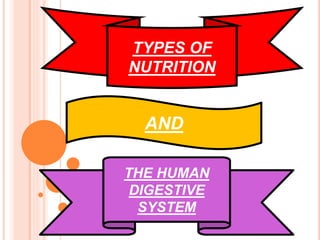
Nutrition and Photosynthesis: The Processes of Plant and Human Digestion
- 1. TYPES OF NUTRITION AND THE HUMAN DIGESTIVE SYSTEM
- 2. The intake of nutrients and utilizing it. Types of nutrition are:- 1.Autotrophic nutrition 2.Hetrotrophic nutrition
- 3. How does this plant takes its food???????
- 4. Do you know how plants get their food??? You don’t know such a simple thing? Plants get their food by the process of photosynthesis .
- 5. Then what is photosynthesi s? The process by which plants take in substances from outside and convert them into stored form of energy is known as photosynthesis.
- 6. For photosynthesis plants need :- 1. Carbon dioxide 2. water 3. & sunlight 1. 2. Sun rays 3.
- 7. Plants contain chloroplast which makes plant’s colour green and helps in photosynthesis. But what does chloroplast contain that helps in photosynthesis?
- 8. Plant cells contain some green dots which are called chloroplast which contains granum & granum contains chlorophyll.
- 9. Plants take up water from the soil by the roots.
- 10. Then how does plants get carbon dioxide????????? Plants take carbon dioxide from air.
- 11. Plants exchange gases through stomatal pores present on the leaves .The exchange of gas also occurs across the surface of stem , roots & leaves.
- 12. Hii friends!! Now let’s learn something about HETEROTROPHIC NUTRITION.
- 13. The type of nutrition which includes the breaking down of complex substances into simpler ones, before they are utilized by the body is called heterotrophic nutrition. It is a type of nutrition obtained by digesting organic compounds. Solid food is converted into soluble compounds so that it is digested well.
- 15. Parasitic Nutrition is a mode of heterotrophic nutrition where an organism (known as a parasite), obtain food from other living organisms (known as a host).The parasite either lives on the body surface or inside the body of the host. PARASITIC NUTRITION???
- 16. HELMINTHES MITES CESTODES LEECH
- 17. Saprotrophic nutrition is the type of nutrition in which the organisms known as saprophytes feed on dead or decaying organic matter. They break- -Proteins to amino acids. -Lipids to fatty acids. -Starch to amylases. SAPROTROPHIC NUTRITION???
- 18. AGARICUS(MUSHROOM) RHISOPUS FUNGUS MUCOR
- 19. Holozoic nutrition is a type of heterotrophic nutrition which includes taking in the complex substances known as food, and converting them into simpler forms. The food is taken in, digested, absorbed, assimilated and then it is ejected.
- 20. DOG LIZARD HORSE FROG
- 23. Do you know where does the digestion starts? Its simple!!digesti on starts in the mouth, also known as the Buccal Cavity.
- 24. Food enters the mouth and it is crushed with the teeth, which is known as chewing. Food gets mixed with the saliva and it is converted into a simpler form. The food gets passed through the oesophagus by the process of peristalsis.
- 25. Hey!! Wait a minute . What is PERISTALSI S? Its simple!! Peristalsis is huh..eh.. eh.. Let him explain. Peristalsis is the process of contraction and relaxation of muscles of the oesophagus, which pushes the food to the stomach.
- 27. Abra kadabra!! Show me the second part of the journey of food. Right away sir!! As you know the food has now reached the stomach from the mouth.
- 29. The food reaches the stomach, where the gastric glands release hydrochloric acid, mucus and pepsin Now the food is passed to the small intestine. Bile juice from the liver gets mixed with the food. Pancreas releases pancreatic juice. The inner lining of the small intestine has numerous finger like projections called villi. Villi increases the surface area for absorption.
- 31. Will anyone tell me the functions of Hydrochlori c acid, Mucus and Pepsin. And the mucus protects the lining of stomach from the action of the hydrochloric acid. Hydrochloric acid creates an acidic medium in which the enzyme known as pepsin acts on the food.
- 32. But what about the functions of the bile juice? Bile juice converts the acidic food coming from the stomach to alkaline, for the pancreatic juices to act. Bile salts break the large fat globules to smaller globules.
- 33. The Gall Bladder stores Bile Juice. The Liver releases Bile juice.
- 34. Then what are the pancreatic juices for? Pancreatic juices contain Lipase for breaking down emulsified fats and Trypsin for digesting proteins.
- 35. The Pancreas secretes Pancreatic Juice
- 36. Will you tell me what happens next? Its simple!! The food now enters the Large Intestine.
- 37. LEFT SPLENIC FLEXURE DESCENDI NG COLON TRANSVERSE COLON RIGHT HEPATIC FLEXURE ASCENDIN G COLON CECUM APPENDI X SIGMOID COLON RECTUM
- 38. The food enters the Large Intestine, where more villi absorbs water. The food is ready for elimination and it reaches a short tube called rectum. The food is eliminated through the Anus.
- 39. DIGESTION FACTS We eat about 500 kilograms of food per year. About a quart of saliva is produced each day. The oesophagus is approximately 8 inches long. Muscles contract in waves to move the food down the oesophagus. This means that food would get to a person's stomach, even if they were standing on their head. Adults stomach can hold approximately 1 quart of material. Every day 9 quarts of digested food, liquids and digestive juices flow through the digestive system, but only two pints are lost as feaces. In the mouth, food is either cooled or warmed to a more
